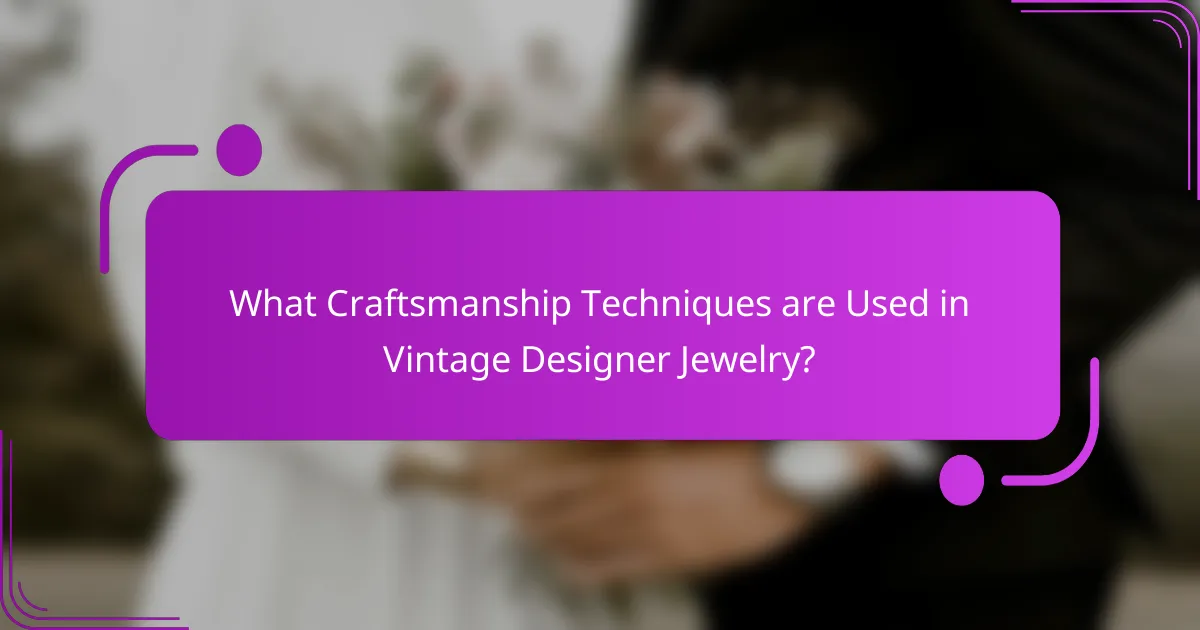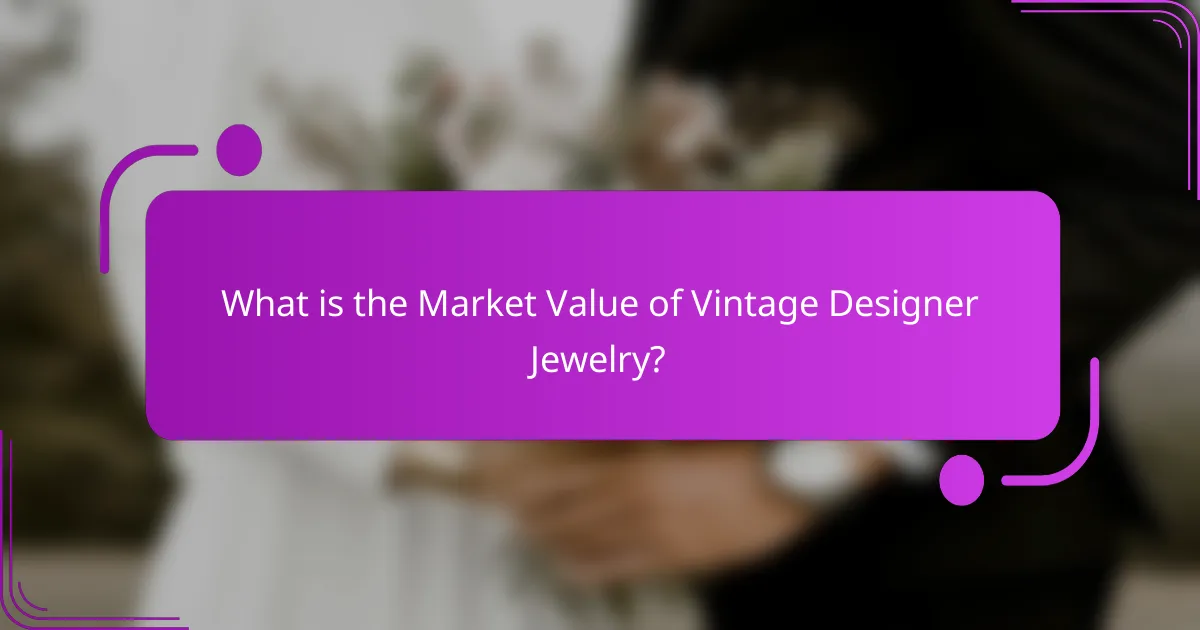Vintage designer jewelry refers to high-quality adornments created by renowned designers at least 20 years ago, showcasing unique craftsmanship and distinctive styles reflective of their era. This jewelry is often made from precious metals and gemstones, with its value influenced by factors such as brand, rarity, condition, and historical significance. Techniques such as handcrafting, filigree, enameling, and stone setting are employed to enhance each piece’s aesthetic and uniqueness. The market value for vintage designer jewelry can vary significantly, with some rare pieces fetching prices exceeding $100,000 at auctions. Notable designers in this category include Coco Chanel and Van Cleef & Arpels, whose works are highly sought after by collectors for their beauty and historical importance.

What Defines Vintage Designer Jewelry?
Vintage designer jewelry is defined as high-quality adornments created by renowned designers at least 20 years ago. This jewelry often features unique craftsmanship and distinctive styles. Each piece reflects the aesthetic trends of its time. Vintage designer jewelry is often made from precious metals and gemstones. The rarity of certain designs increases their value. Provenance and brand reputation also play significant roles in defining vintage pieces. Notable designers include Coco Chanel and Van Cleef & Arpels. Collectors seek these items for both their beauty and historical significance.
How is vintage designer jewelry categorized?
Vintage designer jewelry is categorized based on several criteria. These include the era of creation, the designer or brand, and the materials used. Common eras include Art Deco, Victorian, and Mid-Century Modern. Each era has distinct styles and characteristics. Designers like Cartier and Tiffany & Co. are often highlighted in this categorization. The materials used, such as gold, silver, and gemstones, also play a significant role in classification. Additionally, the condition and provenance can affect the categorization and value of the jewelry. Collectors often seek pieces with a well-documented history. This categorization helps enthusiasts and buyers understand the significance and market value of vintage designer jewelry.
What are the key attributes of vintage designer jewelry?
Key attributes of vintage designer jewelry include craftsmanship, rarity, and historical significance. Craftsmanship refers to the high-quality materials and skilled techniques used in production. Vintage pieces often feature intricate designs and unique artistry. Rarity enhances the value, as limited production runs make certain items highly sought after. Historical significance relates to the era and designer, providing context and desirability. For example, pieces from renowned designers like Cartier or Tiffany & Co. are particularly valued due to their legacy. Overall, these attributes contribute to the allure and market value of vintage designer jewelry.
How does age influence the classification of vintage jewelry?
Age is a critical factor in classifying vintage jewelry. Jewelry is typically considered vintage if it is at least 20 years old. This age threshold helps distinguish vintage pieces from modern designs. For instance, jewelry from the 1980s and earlier often falls into this category. The specific era can further define the style and techniques used in the piece. Additionally, age can affect the market value of the jewelry. Older pieces may be more sought after due to their historical significance. Collectors often prefer items that showcase unique craftsmanship from their respective periods. Therefore, age plays a vital role in both classification and valuation in the vintage jewelry market.
Why is vintage designer jewelry considered timeless?
Vintage designer jewelry is considered timeless due to its enduring appeal and classic design. These pieces often feature high-quality craftsmanship that stands the test of time. The materials used, such as precious metals and gemstones, contribute to their lasting beauty. Additionally, vintage jewelry often reflects the aesthetics of its era, making it desirable across generations. Historical significance also enhances its value, as many pieces are linked to notable designers or cultural movements. Collectors appreciate the uniqueness of vintage items, as they are often one-of-a-kind. This combination of quality, design, and historical context solidifies vintage designer jewelry’s status as timeless.
What historical factors contribute to its enduring appeal?
Vintage designer jewelry’s enduring appeal stems from its rich history and cultural significance. Historical craftsmanship techniques enhance its value and desirability. The unique artistry reflects the fashion trends of past eras, creating a nostalgic connection. Iconic pieces often symbolize important cultural movements or events, adding to their allure. The rarity of vintage items increases their market value over time. Collectors seek these pieces for their investment potential and historical context. Provenance plays a crucial role, as pieces linked to famous designers or celebrities are highly sought after. Overall, these historical factors contribute significantly to the lasting appeal of vintage designer jewelry.
How does vintage design reflect cultural trends over time?
Vintage design reflects cultural trends over time by encapsulating the aesthetic values and societal norms of specific eras. Each vintage piece serves as a historical artifact, showcasing the materials, styles, and craftsmanship prevalent during its creation. For example, Art Deco jewelry from the 1920s highlights the era’s fascination with modernity and geometric forms. Similarly, Victorian jewelry often reflects the romantic ideals and social values of the 19th century. The resurgence of interest in vintage design also indicates a collective nostalgia for past aesthetics in contemporary culture. This nostalgia often aligns with broader cultural movements, such as sustainability and a preference for artisanal craftsmanship. Thus, vintage design acts as a mirror, reflecting the evolving tastes and values of society across different time periods.

What Craftsmanship Techniques are Used in Vintage Designer Jewelry?
Vintage designer jewelry employs techniques such as handcrafting, filigree, enameling, and stone setting. Handcrafting involves artisans creating pieces individually, ensuring uniqueness. Filigree is a delicate technique where fine metal wires are twisted and soldered into intricate designs. Enameling adds color and texture through the application of glass powder, which is then fired. Stone setting secures gemstones in various styles, enhancing the piece’s overall aesthetic. These techniques are rooted in historical craftsmanship practices, often passed down through generations. The use of these methods contributes to the distinct character and value of vintage jewelry.
How do artisans create vintage-inspired designs?
Artisans create vintage-inspired designs by studying historical styles and techniques. They often analyze specific periods, such as Art Deco or Victorian, to capture their essence. This involves selecting materials that reflect the era’s aesthetic, like gemstones and metals commonly used in those times. Artisans employ traditional crafting methods, including hand-setting stones and intricate metalwork, to replicate authentic designs. They also incorporate vintage motifs, patterns, and colors to enhance the authenticity of their pieces. Attention to detail is paramount, ensuring that every element aligns with the vintage theme. By blending modern techniques with historical inspiration, artisans produce pieces that resonate with nostalgia while maintaining quality craftsmanship.
What materials are commonly used in vintage jewelry craftsmanship?
Common materials used in vintage jewelry craftsmanship include gold, silver, and platinum. These metals provide durability and aesthetic appeal. Gemstones such as diamonds, sapphires, and emeralds are also prevalent. They enhance the visual richness of the pieces. Additionally, materials like pearls and enamel are frequently incorporated. Pearls add elegance, while enamel offers vibrant color options. Vintage jewelry often features intricate designs made with these materials. Historical context shows that artisans prioritized quality and craftsmanship, leading to lasting value.
How does the craftsmanship differ between eras?
Craftsmanship in vintage designer jewelry differs significantly between eras. Early craftsmanship emphasized handwork and artisanal techniques. Jewelers often used traditional methods, resulting in unique pieces. The Art Deco era introduced geometric designs and machine-assisted production. This led to increased precision and mass production, affecting individuality. In contrast, contemporary craftsmanship often incorporates modern technology. Techniques like 3D printing allow for intricate designs not possible before. Each era reflects the cultural and technological advancements of its time. For example, the Victorian era showcased elaborate detailing, while the Mid-Century Modern era favored simplicity and clean lines. These differences highlight the evolution of style and technique in jewelry making.
Why is craftsmanship important in determining value?
Craftsmanship is crucial in determining value because it reflects the quality and skill involved in creating an item. High craftsmanship often results in superior materials and techniques being used. This enhances the durability and aesthetic appeal of the piece. Vintage designer jewelry, for example, often commands higher prices due to exceptional craftsmanship. Historical data shows that pieces with intricate designs and attention to detail appreciate more over time. Furthermore, craftsmanship influences authenticity and uniqueness, making items more desirable to collectors. In summary, craftsmanship directly correlates with perceived value in the market.
What specific techniques enhance the quality of vintage jewelry?
Techniques that enhance the quality of vintage jewelry include meticulous restoration, careful cleaning, and proper storage. Restoration involves repairing any damage while preserving original materials. Cleaning techniques often use gentle solutions to avoid damaging delicate surfaces. Proper storage protects vintage pieces from environmental factors. Additionally, using appropriate display methods can prevent wear and tear. These techniques ensure the longevity and aesthetic appeal of vintage jewelry. Historical preservation methods are often employed to maintain authenticity and value.
How can craftsmanship affect the longevity of vintage pieces?
Craftsmanship significantly impacts the longevity of vintage pieces. High-quality craftsmanship ensures durable construction and materials. Expert artisans use techniques that withstand wear and tear. For instance, hand-stitched seams in vintage clothing enhance durability compared to machine stitching. Additionally, attention to detail in jewelry design prevents structural weaknesses. Historical examples show that well-crafted items often last decades or even centuries. Vintage pieces from renowned designers maintain their value due to superior craftsmanship. This longevity is evidenced by the continued demand for such items in the market.

What is the Market Value of Vintage Designer Jewelry?
The market value of vintage designer jewelry varies widely. It typically ranges from a few hundred to several thousand dollars. Factors influencing this value include brand, rarity, condition, and historical significance. For example, pieces from iconic brands like Chanel or Cartier can command higher prices. Recent auctions have shown that rare vintage pieces can exceed $100,000. Additionally, market trends fluctuate based on collector demand and fashion cycles. Overall, the market value is dynamic and reflects both the jewelry’s intrinsic qualities and external market conditions.
How is the market value of vintage jewelry assessed?
The market value of vintage jewelry is assessed through several key factors. Appraisers consider the jewelry’s age, brand, and condition. Provenance, or the item’s history, also plays a significant role. Market demand influences valuation significantly. Recent sales data of similar pieces provide a benchmark for pricing. The materials used, such as gold, silver, or gemstones, impact value. Unique attributes, like limited editions or designer signatures, can increase worth. Appraisals often involve expert evaluations from certified professionals.
What role do appraisals play in determining value?
Appraisals play a crucial role in determining the value of vintage designer jewelry. They provide an expert assessment of the jewelry’s worth based on various factors. These factors include the piece’s craftsmanship, materials, and historical significance. A qualified appraiser evaluates these attributes to assign a monetary value. This value is essential for insurance purposes, resale, and estate planning. Appraisals ensure that owners understand the true market value of their jewelry. Accurate appraisals can also influence buyer confidence in the market. Thus, appraisals are integral to establishing and communicating the value of vintage designer jewelry.
How do rarity and demand influence market prices?
Rarity and demand significantly influence market prices. When an item is rare, its scarcity increases perceived value. High demand for a limited supply can drive prices upward. For example, vintage designer jewelry often sees price increases due to both rarity and brand prestige. Historical auction results show that unique pieces can sell for multiples of their original prices. In contrast, items that are abundant and have low demand typically experience lower prices. The interplay between rarity and demand creates a dynamic pricing environment in the market.
What trends are currently shaping the vintage jewelry market?
Sustainability is a major trend shaping the vintage jewelry market. Consumers increasingly seek eco-friendly options. This trend promotes the reuse and recycling of materials. Additionally, authenticity is highly valued. Buyers prefer pieces with verifiable provenance. The rise of online marketplaces has expanded access to vintage items. Social media influences consumer preferences and trends. Furthermore, there is a growing interest in unique, one-of-a-kind pieces. This interest drives demand for distinctive designs from various eras.
How do auctions and sales impact market value?
Auctions and sales significantly influence market value by establishing a price point based on buyer demand. These platforms create competitive environments where bidders drive prices up. For instance, a vintage designer jewelry piece may sell for much higher at auction than its estimated retail value. This occurs because auctions attract collectors willing to pay premium prices. Sales, particularly limited-time offers, can also create urgency, leading to increased demand and higher prices. Historical data shows that unique pieces often appreciate in value after successful auction sales. Therefore, both auctions and sales serve as critical indicators of market value in the vintage jewelry sector.
What are the most sought-after vintage designer brands?
The most sought-after vintage designer brands include Chanel, Louis Vuitton, Gucci, and Hermès. Chanel is renowned for its classic handbags and haute couture. Louis Vuitton is famous for its iconic monogram bags and luggage. Gucci is celebrated for its bold designs and quality leather goods. Hermès is particularly known for its luxury silk scarves and the coveted Birkin bag. These brands consistently hold high resale values in the vintage market, reflecting their lasting appeal and craftsmanship.
What tips should collectors consider when investing in vintage designer jewelry?
Collectors should consider authenticity, condition, and provenance when investing in vintage designer jewelry. Authenticity ensures the piece is genuine and not a replica. High-quality pieces often come with certificates or documentation. Condition affects both value and desirability. Look for signs of wear and restoration. Provenance provides a history of ownership, enhancing the piece’s story and value. Research the designer’s reputation and market trends. Understanding these factors helps collectors make informed decisions. Collectors should also seek expert appraisals for accurate valuations.
Vintage designer jewelry is characterized by high-quality adornments created by renowned designers at least 20 years ago, showcasing unique craftsmanship and distinctive styles. This article explores the categorization of vintage jewelry, key attributes such as craftsmanship and rarity, and the influence of age on classification and market value. Additionally, it examines historical factors contributing to its timeless appeal, craftsmanship techniques used, and current market trends affecting value. Collectors are provided with essential tips for investing in vintage designer jewelry, emphasizing the importance of authenticity, condition, and provenance.